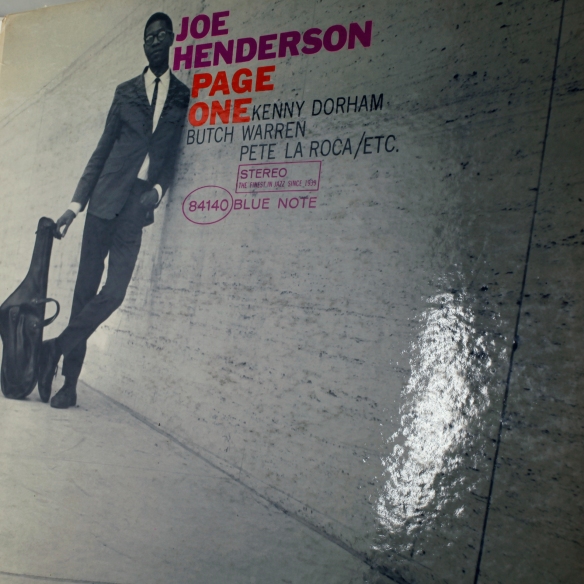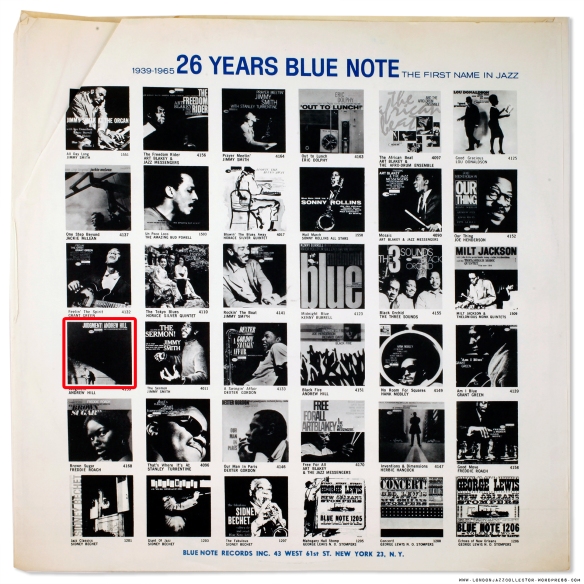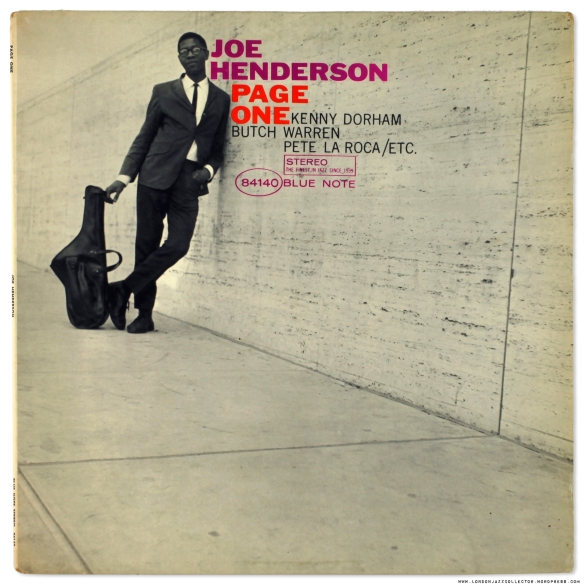. . .
Impossible to choose a best track, all of them are outstanding. The most widely played is probably Dorham’s sprightly Blue Bossa, or Henderson’s Recorda-me, both their respective signature tunes, so I’ve chosen as the selection the more obscure, less easily pronounced and even harded to spell, swinger Jinrikisha, which is apparently Japanese for a rickshaw, a two-wheeled passenger cart pulled by one person, not to be confused with a trishaw three wheel cycle cart. Possibly. Our friends from Japan can fight over this.
Artists
Kenny Dorham, trumpet; Joe Henderson, tenor sax; McCoy Tyner, piano; Butch Warren, bass; Pete La Roca, drums; recorded Van Gelder Studio, Englewood Cliffs, NJ, June 3, 1963, released in October 1963.
If you were wondering about the artist named “/ETC.” on the cover, or failed to register it, it is a thinly disguised reference to McCoy Tyner, who in 1963 had just signed to Impulse Records. Though he is credited on the back, supposedly his Impulse contract forbade front cover credits.
Dorham is the old hand of the group here, shortly to turn forty, with everyone else in their mid twenties. Rather than his well-established pairing to date with Hank Mobley, Dorham introduced Joe Henderson to Blue Note on his own Blue Note title, Una Mas, fostering Joe’s early career. Clean-shaven Henderson looks impossibly young on the cover, which is a masterpiece of minimal design by Reid Miles, a perfect demonstration of the rule of thirds, (as opposed to the “stick it in the middle” school of mobile phone photography)
Music
Page One is aptly named, Henderson’s debut album as leader, for Blue Note. The songs offer an upbeat line in Bossa Nova, whose strong rhythmic accent seems to have worn better than its syrupy Afro-Brazilian cousin Samba. (La la la, la la, lala, the girl from Ipanema called, but I never called her back). The songs range from bluesy romps, a minor-key outing, a delicate whistful ballad, and fiery swingers, all with a backbone of compositional authority.
One of the best elements of the album is the front-line pairing of Dorham’s peppery darting trumpet offset by Henderson’s hard gruff tone, carrying off the melodies in lively skipping and swaying harmonic lines.
Henderson’s solo power is vital: varying speeds, deliberate slow or fast energetic bursts of Coltrane influences, hard tone, architectural solo structure, pedal-points in interesting places, full use of the register, harmonic honking technique which he developed further ( showcased on Duke Pearson’s Wahoo). Page One is an iconic essential album high up in the Blue Note Hall of Fame.
Vinyl: Blue Note BST 84140 Van Gelder stereo master, Plastylite, NY labels, no grooves.
Van Gelder’s stereo touch had matured by 1963. The quintet is nicely positioned on the soundstage, musicians in the room, and the engineering is lovely: fresh articulation of each instrument, full dynamic and tonal range, perfect balance, and musical cohesion between the players, no stereo-theatrics and special effects, no artificial bass-boost. This is what Blue Note is all about, it just makes you want to listen. No need to attract your attention, it already has it, effortlessly.
Original laminated cover, one of the last dozen Blue Notes to benefit from this wonderful dimpled reflective surface, which seemingly no-one can replicate today, instead just flat glossy plastic. UPDATE: (see comments) Milan shows latest Disk Union Blue Note replica editions with classic dimpled laminate, shows it can be done.
 NY Labels, and perfect inventory run-out, all there as should be.
NY Labels, and perfect inventory run-out, all there as should be.
 Warning! Inner Sleeve Geek Factor 9.
Warning! Inner Sleeve Geek Factor 9.
This record (un)helpfully came with a Blue Note inner sleeve, unique design, Andrew Hill “Judgement” (BLP 4159) Column 1 Row 4, on the side of the inner sleeve with the Blue Note address at the bottom, 43 West 61st (the other side of the sleeve has no address)
This sleeve is associated with 4178 – 4201, titles released between May – September 1965, manufactured probably in the previous two to three months. This was the minimum time from recording studio to record store rack with Blue Note, though sometime longer according to Alfred Lion’s sense of market artist-saturation (Jimmy Smith exempted)
 Henderson’s Page One was released three months after the recording session, in September/October 1963. It should not have an inner sleeve that came in to use eighteen months later. Bummer.
Henderson’s Page One was released three months after the recording session, in September/October 1963. It should not have an inner sleeve that came in to use eighteen months later. Bummer.
Though perhaps not? If you were selling, you “lose” the inner sleeve. Now you can shout from the rooftops: “Original NY labels! (true) Plastylite ear and Van Gelder stamp (true)! Original laminated cover (true) with the 43 West 61st address! (also true but irrelevant) Original Pressing! (probably not true, but who’s to know?)
 As we are being asked to stay home, and without friends visiting, I have taken the opportunity to sift through records that haven’t been played a while. It is re-aquainting me with some old vinyl friends, no social distancing required.
As we are being asked to stay home, and without friends visiting, I have taken the opportunity to sift through records that haven’t been played a while. It is re-aquainting me with some old vinyl friends, no social distancing required.
When everything around you seems safe, you feel comfortable with danger. I guess it works the other way round too. Having in recent years poked my toe gingerly into more knotty and demanding work, suddenly the comfort of these old friends has offered much needed company.
Checking through my list of 800 posts (!) I was also shocked to find I had introduced only two of my Joe Henderson Blue Notes on LJC: the apostrophe-challenging In ‘n’ Out (4166), and Inner Urge (4189). Not a peep on my Mode For Joe (4227), Our Thing (4152) , and Page One (4140), all of which were acquired ten years ago, early in my collecting career. Somehow, in the excitement of the chase for more records, I had overlooked writing about these. They were lounging on the shelves. Time to blow off the dust, fire up the ultrasonic record cleaner for a first blast, and make something good come from something bad.
Writing on Page One took me ten years back in time.
In 2010, in short trousers as a jazz collector, I had just discovered the excitement of Ebay – though not yet the pain. Bids counting down the seconds in real time on the screen, some in the small hours, accommodating Eastern Daylight Time (GMT-5) or Hawaii-Aleutian Standard Time (GMT -10), before the likes of Gixen and clinical remote server bidding, sensible head on, took away the adrenaline rush of the real-time auction.
It was also a time before the Customs Collection crackdown on importation, the point record sellers became collecting agents of the Inland Revenue, and records were held hostage by our own postal authorities. They were good times to buy records in auctions. Well, fairly good.
They were times when you discovered transatlantic differences in opinion over record grading, and the real meaning of condition description “does not affect play” . Yes, this record can be mounted on a turntable, and yes it can be played. Every word is true, you are on your own with a “not as described” claim.
Just a few bad things happened, but mostly it was fun, and if you wanted Blue Note (all I collected in the beginning) you had to go to where the Blue Note records were: America.
At the time I mostly sought out the mono edition, but I think I overlooked Page One’s stereo provenance in the excitement of bidding. Careless but as a rookie I made a few mistakes and it was the stereo that appeared in my mail box from Ebay, Congratulations! Now time to pay! And pay I did, over $100, more than any other auction success at the time, but on reflection, I’m happy that I did. It’s only money. You can’t play money. It doesn’t sound any good. And where are these records now? Mostly, Japan.
Though Henderson went on to lead four more titles for Blue Note, Page One is the one I came back to most, for it’s joyous positivity, something we all need more of in these unsettling time.
There is enough bad news around, I had to stop consuming the endless “Daily Getsworse!” media, just the sombre headlines with an early evening glass in my hand. Hopefully a restocking case from the wine merchants will arrive tomorrow, home delivery.
 If there are any stories of the benefits of “staying home”, feel free to share. In the meantime, stay safe, stay home, enjoy jazz!
If there are any stories of the benefits of “staying home”, feel free to share. In the meantime, stay safe, stay home, enjoy jazz!
Plenty more to come.
LJC



hi LJC,
I’m curious about one thing. My original stereo copy of page one has some continuous noise that can be heard occasionally on side two, while side one plays perfectly. I’m sure that this is not from scratches because i got an ex copy. Will it be groove wear or a pressing defect that all og stereo 4140 have?(i don’t think its groove wear since it doesn’t sound like how groove wear normally sound like.)
best wishes from China
David
LikeLike
Hi David, greetings, and helooo.. China?
Can’t say I have noticed any noise issues with my copy of Page One, but I am not very sensitive to distortion personally. If it is on Side two but not Side one, it does sound like a fill-issue rather than cartridge tracking, though that can’t be eliminated unless you have gone through all the cartridge set-up checks. You say it is intermittent on the Side two, which suggests a batch problem in manufacture rather than a problem with the original recording, which is sometimes where the finger points. I reckon Blue Note will have pressed around 4,000 copies for the initial release (more mono than stereo), and then repress in occasional batches to top up dealer inventories. The initial stock of labels would cover a lot of repressings, so there is no certainty that anissue would be found on every copy. Could be there was a passing problem. One press would take a week to complete the run, each day could be different.
Don’t know if anyone else can confirm the same issue with their copy – wisdom of crowds
Sent from Mailhttps://go.microsoft.com/fwlink/?LinkId=550986 for Windows
LikeLike
thanks for reaching back.
i think it might be a pressing issue that only exist in a small batch of vinyl. i asked my friend who had owned two stereo og pressing of page one and he said that both of the records had minor noise at the beginning and ending part of both sides. Maybe record pressed in different batches can bear varied defects. My pristine og stereo Fuego also have the same kind of problem. it seems pressing issue is a normal preblem at that era.
LikeLike
Hi, great posts, as always. Just one question, not related to sleeves. Did anyone notice that the last tune on side 2 has a different mix. Saxophone and trumpet change the positions on the speakers in comparison to the remaining tunes of this set. Can it be that it comes from a different session, or has it to do with my release (Liberty, stereo 67′).
LikeLike
To clarify sources, do you have the East Coast Liberty reissue (left) or the West Coast Liberty reissue (right)
It makes a difference, as the East Coast are usually represses from the original Van Gelder metal, and the West Coast remasters from copy tape, where it is possible something went on in remastering. Unlikely but possible
Also is the matrix etched with an A1 or B1 sufix, indicating a second Van Gelder mix? Again, unlikely but possible.
I am away from my kit but please, anyone welcome to throw in an answer
LikeLike
Thanks for the feedback, it is the left one, East Coast pressing; Liberty label on one side, New York on the other, with 84140A/B ser. no. The song which seems to me from another mix is “Homestretch”, last song on side 1. Sax and trumpet are inversed in comparison to the rest of the record.
LikeLike
Not sure this helps but there are two takes of “Homestretch” according to JazzDisco: Take 25 and Take 22 – different line up, different date? Jazzdisco is confusing me, no idea what is going on.
Joe Henderson – Page One (Blue Note BLP 4140)
Kenny Dorham, trumpet; Joe Henderson, tenor sax; McCoy Tyner, piano; Butch Warren, bass; Pete La Roca, drums.
Van Gelder Studio, Englewood Cliffs, NJ, June 3, 1963
tk.6 Recorda-Me
tk.12 Jinrikisha
tk.14 Blue Bossa
tk.18 La Mesha
tk.20 Out Of The Night
tk.25 Homestretch
** also released on Blue Note BST 84140, CDP 7 84140 2, BST 84140.
** part of Mosaic MD5-271 as The Complete Joe Henderson Blue Note Studio Sessions.
The Complete Joe Henderson Blue Note Studio Sessions (Mosaic MD5-271)
same session.
Van Gelder Studio, Englewood Cliffs, NJ, June 3, 1963
tk.15 La Mesha (alternate take)
tk.22 Homestretch (alternate take)
Kenny Dorham, trumpet; Joe Henderson, tenor sax; Andrew Hill, piano; Eddie Khan, bass; Pete La Roca, drums.
Van Gelder Studio, Englewood Cliffs, NJ, September 9, 1963
LikeLike
I have the research craft pressing mastered by Bert Agudelo and on the dark blue label with black “b” logo. It sounds nice, and the music is incredible, but I have no Van Gelder metal copies to compare it to. it’ll have to do until I can find another copy. Anyone able to provide any insight relative to this pressing?
LikeLike
I actually can give you an opinion on this. I ordered this version thinking it was one pressed with Van Gelder metal as the seller wrote “Van Gelder stamps” in his description. However, when it arrived, it was the remastered Bert Agudelo version. I played it, and it sounded nice. But it wasn’t what I ordered and paid for, so I returned it. I just received another dark blue label version with a white “b” logo with Van Gelder and Stereo stamps. I must tell you, it sounds absolutely phenomenal. I would recommend getting your hands on a Van Gelder version if you can. I know sometimes the later Van Gelder issues don’t have the same snap as the earlier versions, but this copy is phenomenal and it was a fraction of what originals or early represses sell for. Not even $75!
LikeLike
I love your posts and often find hitherto unknown gems from your wonderful archive of opinion.
Please keep doing what you’re doing and know that it’s resonating with many out there…
LikeLike
Always good when a LJC review arrives in my in-box. Great music and slyly amusingly written too. Keep up the good work.
LikeLike
Incredible album, my favorite by Henderson, for all the reasons cited above. Your side story about the inner got me a little worried, so I pulled my original mono pressing off the shelf and looked at the details of the inner: 43 W 61st address, same as the cover, no year on the top bar, so I assume this is a first pressing? For some reason I’ve never paid too much attention to the forensic science of the inners, maybe because I don’t always consider them reliable (they are easy to replace/swap/mix up in the decades since these records were released), so I’d never use them as a last word.
My previous copy of “Page One” was a stereo, and I agree that it sounds terrific, I can still remember being blown away the first time I played it, and I can’t recall feeling like this with every record in my collection.
LikeLike
What a great album! I have a 1967 Liberty pressing with a Keystone label. The dead wax is identical – including the handwriting – to the one on your photos (except for the P, obviously). It has the laminated cover too. One of my favorite records to spin.
LikeLike
I was fortunate to be shooting photos (as a local newspaper photographer) at the Monterey Jazz Festival when Joe Henderson played there. I brought a United Artists Blue Note LP and he graciously signed it. He was as great as advertised, on stage, and off.
Here in California (near San Francisco), we’re on a voluntary lockdown, and have been for about 10 days. It’s been surreal, as I’m sure it is for all of us. Suffice to say, I’m listening to a lot of jazz and finding ways to enjoy the little things. Looking forward to LJC’s continued thoughts on all things jazz.
LikeLike
I need this record. Blue Bossa is part of my very best repertoire, over which I can comfortably solo and lay down a nice line.
LikeLike
Good post! I am currently on the hunt for a Plastilyte copy and it’s crazy to see how the prices have gone up for original BN. “Over $100” in 2010, even taking into account 10 years of inflation, seems really low compared to current prices, today it seems you need more than 4 times that amount for a decent copy!
LikeLike
Nice post as always! I wonder how one could “forget” to have a first pressing of “Page One” – I’m still looking for a copy, don’t care if mono or stereo.
I disagree on your assessment on modern laminated covers: while it is true that 99,9% of all reissues and new releases use the flat lamination process, the last Blue Note reissue series from Japan (Disk Union, all mono, mastered by Kevin Gray from the original master tapes) replicated the original covers to the last detail, including the dimpled lamination. I took some pictures and hope it helps bring my point across:
All the best,
Milan
LikeLike
Never seen anything like these until now, thank you, they are quite beautiful. Bravo the boys from Tokyo
LikeLike
What would be the actual difference between lamination and varnish in the printing and finishing business? Is the lamination an actual additional sheet layered onto the sleeve?
LikeLike
Working from home this past week, using my listening room as my home office. Pretty close to perfect …
LikeLike
I see that’s a 1963 pressing…Guess i missed it at Plastylite, as I pressed there in 1964/1965…
LikeLike
Hi Larry, a very rare and useful experience! What did you do at Plastylite, a press operator? Tell us more. Do you know anything about these inner sleeves the records were bagged in? Anything about the process of pressing process, I’m sure many of us collectors would love to know more about it.
LikeLike
I get that inner sleeves can serve as indicators for first or later pressings, but that would only hold true if one can without a doubt guarantee that the inner sleeves hasn’t been swapped from another LP. I have at least 3-4 Blue Note LPs that are first pressings (Deep Groove on both sides, address on label, ear, address on back of the cover etc.) that have inner sleeves originating from 1965 onwards and later “earless” pressings with inner sleeves going no further than BN 4050. Imagine how much jazz fans interchanged inner sleeves after listening to their LPs (best case scenario, since many just tossed and left them without any protection sleeve-wise) because they had several laying around from previous listening sessions – people weren’t as meticulous in preserving discs back then (unfortunately). They certainly didn’t have the expertise nor the interest placing the LP back in the correct sleeve with matching catalogue numbers in case of doubt – they just used what was laying around. So I guess inner sleeve information should always be taken with a grain of salt, in my humble opinion of course.
Best,
Milan
LikeLike
You make a very good point about the limitations of inner sleeve information, Milan. Inner sleeves surely got swapped during the heyday of LP buying. I recall going to friends houses and seeing records, inner sleeves, outer sleeves, you name it, lying all over their listening area. Deplorable record hygiene! Used records can arrive in stores with no inner sleeve, so the proprietor takes one from the stack of extras and slips the disc right in. And it was not unheard to replace the inner sleeve with a poly-lined sleeve and discard the original. Does that me such a record could never be considered “first pressing” because it doesn’t have that last bit of authenticating evidence? I don’t think so.
LikeLike
Gentlemen, some discussion on the topic of sleeves? It’s another slow day in isolation.
About half my Blue Note collection of 200+ have an unrelated inner sleeve – most often a modern replacement or yellowed old plain sleeve unrelated to Blue Note. Many originals were indeed lost or swapped over the years.
Of those 1961-66 Blue Notes that have a picture inner sleeve present , very few have the “correct” first original release sleeve, perhaps only a quarter, usually the premium collector quality copies.
The great majority have an inner picture sleeves later than the original release sleeve, none if any had an earlier sleeve. The mismatches were not “random”, which one might expect from accidental mixing up. They were almost always later inner picture sleeves. To me this prompts a different explanation.
My hypothesis is that more copies of popular Blue Notes were pressed according to demand, often perhaps a couple of years later, which will have been bagged in a later sleeve. That might explain the frequent appearance of later inner sleeves more than (random) mixing up, though I am sure some of that occured too.
I’m not sure it matters whether you have a copy from the “original”release pressing run or a repress a year or two or three down the line: within the NY label period (62-66), there is no (other) way to tell them apart.
Back in the 60s when I was a lazy teenager , and I used to leave the inner sleeve “mouth open” still inside the jacket, so few if any inner sleeves saw the light of day, let alone got mixed up, but maybe other people’s practice differed.
LikeLike